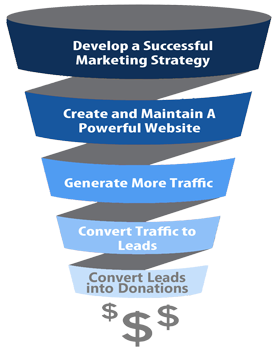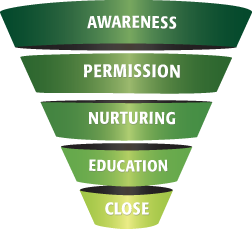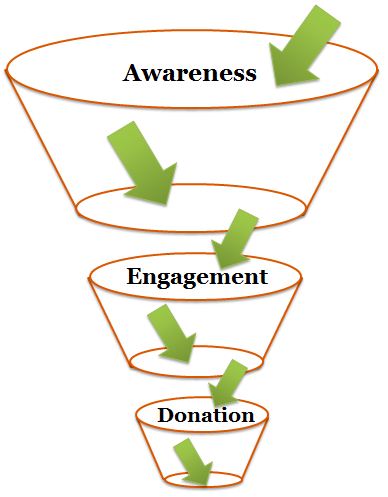Making the Donor Funnel Work for Your Nonprofit

Donations are absolutely critical for almost all nonprofit organizations. Whether large or small, every bit helps; these dollars go towards ensuring your nonprofit can provide essential services for clients, and for the furthering of causes. But to invite donations, there’s more to it than placing a “Donate via PayPal” button on your website. There’s nothing wrong with that, but there needs to be motivation for individuals to donate their hard-earned cash, a streamlined and repeatable process. A donor “funnel” aims to do exactly that, and is comprised of a few key parts. Working from the top down, these components are:
Successful Marketing Strategy
At the top of any successful donor funnel is a well-researched and planned strategy for marketing. This is represented by the top of the funnel—its widest part—because it is responsible for attracting the largest audience possible. Granted, not every one of these individuals will end up becoming a donor, but that’s okay; the point of this phase of the funnel is to build a mass audience from which “leads” can be nurtured further down the line. This marketing strategy will attract potential donors via a greater online presence, in turn pointing them towards your website.

A Powerful, Robust Website
Once your marketing campaign pushes individuals to your website (through varying means, such as Facebook, Twitter, email, etc.), it is the responsibility of your website to rouse their interest. And as the saying goes, “content is king,” and it is only with rock solid content that your nonprofit stands a chance at online fundraising. Just imagine visiting a nonprofit organization’s website, only to find a couple pages and a handful of blogs. Sure, they mention that they are looking for donations, but is that really enough to motivate you?
On the other hand, think of an alternative: the nonprofit’s website is expansive and yet concise in its focus on their cause. There are multiple pages providing information about their beliefs, causes, founders, staff, activities, events, etc. Their blog includes lengthy case studies detailing how donations have successfully furthered their cause. Sounds like a nonprofit you’d consider giving to, wouldn’t you agree?
Generate Greater Traffic
The goal of website content is to attract even more readers through social circles, whether it’s Facebook, Twitter, LinkedIn, etc. It should resonate with the individual to the point where they pass it along to their friends. This process allows your nonprofit’s content to spread from a reader to their friends, and so on, traveling quickly into unexpected social graphs.

Convert Traffic to Leads
At this point in the funnel, readers have been attracted to your nonprofit’s website, and they have enjoyed its content enough to pass it along to their friends, creating an even broader readership. Now is the time to work on actually converting your readers into leads. A lead, quite simply, is someone who has expressed interest in what you do. For instance, if someone has signed up for your newsletter, it’s safe to say they have interest in your nonprofit. Those users are more concrete, but there are also somewhat “softer” types of leads, including those who have commented on a blog or follow your nonprofit via social media. This point of the funnel is a bit more of an art than the previous ones, but it is where a visitor’s interest level must be assessed before they are converted to donors..
Nurture Leads Towards Donation
The “nurturing” process is all about gradually compelling leads to donate. It is about building a relationship, proving that that your nonprofit’s beliefs are aligned with theirs. This is a two-way process, equal parts give and take. You should be listening to your leads, and provide value in return. Tracking interactions here has can provide essential data to ensuring your efforts are worthwhile and repeatable. Once a lead has been converted to a donor, count it as a win. But there’s no reason to stop there; many nonprofit organizations pay extra special attention repeat donors and reward them for their generosity.
As with most things in the world of marketing, the metrics—or “science”—are extremely important, but there’s also room for the “human” aspect of the process. Don’t think of leads just as a potential donor. Think of them as people. Go the extra mile to let them know you care. This doesn’t have to be for every single lead, but enough to show your nonprofit cares about fostering genuine relationships with those who want to better their community.





